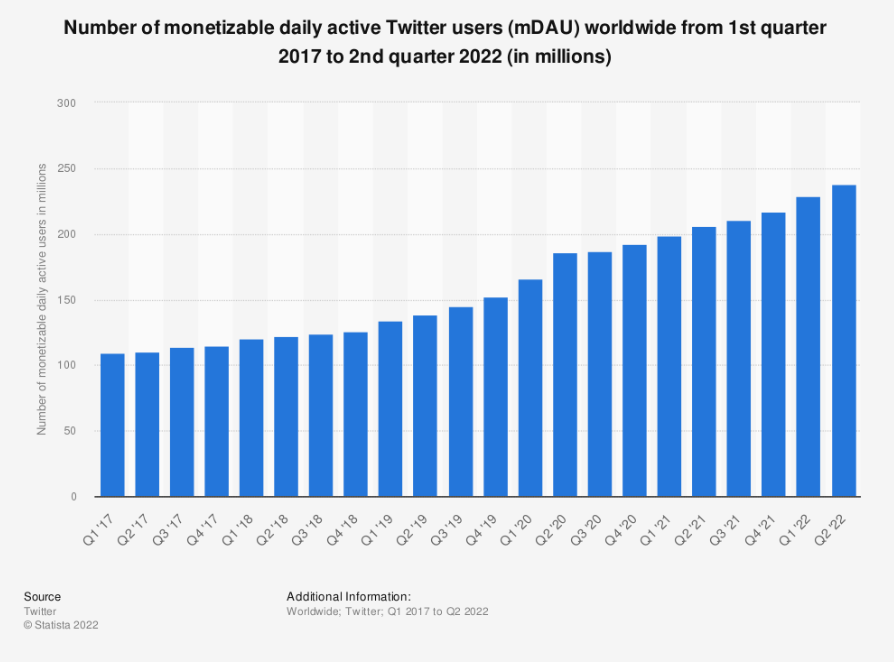Elon Musk ultimately acquired Twitter for $44 billion by the end of October after months of rumors, backtracking, lawsuits, backtracking, and more lawsuits. Since then, he has turned the business upside down by firing employees, discontinuing remote work, and sowing discord among his staff.
You’ve probably heard the adage “if it ain’t broke, don’t fix it.” Twitter went through a difficult time before Musk bought the company, despite the company’s outward appearance of strength. Several sources claim that the prior management of Twitter intended to lay off almost a quarter of the workforce.

Additionally, Twitter’s faced stagnant growth over the past five years, peaking at just over 200 million daily active users. On the other hand, Meta’s products boast significantly more usage. Facebook gets 1.9 billion daily users. Instagram has 500 million and is on track for more growth. When comparing Twitter’s growth to other social media companies, it’s clear that it needs to do more.
Twitter 2.0
Musk promised to release features at a faster pace, allow free speech on the platform, and prevent spambots. He started by releasing a paid verification feature, allowing average users to have the iconic blue tick for $8/month. This led to increased spam on the platform, particularly with users impersonating major accounts, including Tesla. Eli Lilly, a pharmaceutical company, saw its stock crash after a verified impersonating account tweeted that insulin would now be produced for free.
Twitter Blue verification, the feature enabling paid blue ticks, was temporarily suspended, with Musk claiming it’ll be restored by the end of the month.
That was until a few days ago when Musk sent out an email to employees asking them to agree to “extremely hardcore” work; otherwise, their contract will be terminated the next day.
Mass layoffs
Reports claim that hundreds of employees declined Musk’s offer, leading to further loss of his already reduced workforce. It’s likely that senior workers, with longer years of experience and more job opportunities, were the ones that left Twitter this week. This poses further trouble for Twitter, as the company certainly lost experienced engineers who understand the codebase better than most.
A common myth in app development is that once the app is built, it can run smoothly with no extra work. However, large apps in particular face critical system errors pretty frequently, requiring engineers to put out fires as soon as they start. This is to minimise the impact on users.
Additionally, such companies have many different codebases and “micro-services”, each written with some level of uniqueness. This leads to knowledge silos, where some knowledge of the codebase is held by just a handful of engineers, sometimes even just one. The mass departure of many engineers means that it’s likely there are some codebases which are no longer maintained by any engineer. This means that it would take significantly longer to fix critical issues, as they may now require fixing by engineers that are not familiar with the breaking codebase.
Such a situation should ring up alarms if it happens in any business, particularly if it takes place over the weekend. As most people are off on weekends, it means that on-call systems may have no engineers assigned to them, and the remaining employees wouldn’t have had a chance to take on or train for new responsibilities yet.
What makes the situation even more catastrophic is that the World Cup takes place on Sunday, just two (weekend) days after Twitter lost many critical employees. Since Sunday is a weekend in the USA, where Twitter’s main headquarters are located, the platform is expecting a mass surge in critical errors (as a result of significantly increased usage).
If you think of Elon Musk as a captain of a large ship, he effectively threw more than half his staff off the ship right as he’s heading into the biggest storm he’s ever seen.
Twitter could sail through the storm, but it could very well break down too.
It’s doubtful that a little outage will destroy Twitter. However, frequent outages during the World Cup can tempt consumers to go to other social media platforms. This includes well-known behemoths like Facebook, Instagram, and even Tumblr. It might also be the last straw that convinces users to switch to a new platform like Mastodon, which aspires to take the place of Twitter.
To be clear, it is quite improbable that Twitter will stop functioning altogether during the World Cup. However, it shouldn’t come as a surprise if it experiences more downtime. As a result, users may start looking for an alternative app that actually functions.

















Leave a Reply